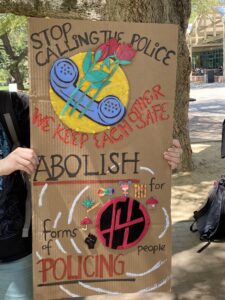Intro to Affinity Groups
Posted: August 31st, 2022 | Author: ucdcoc | Filed under: Disorientation Guide '22-'23 | Comments Off on Intro to Affinity Groups
Affinity groups are self-sufficient support systems of about five to fifteen people who build trust, choose to struggle and work together, and share “affinity” in ideas, visions, and goals. Affinity groups are composed of people who have been brought together through movements or have existing ties such as friendship, living in the same area, or working together. The goal of an affinity group is action and might be better conceptualized as a crew of people who are down for similar things, whether it be political education, sabotage, “street art,” campaigns, publishing etc. “Abolish the UC” is an example of a type of larger affinity group, but they can also take the form of a group of friends who come together to feed unhoused community members or a prisoner support group. Sometimes, affinity groups remain together over a longer period of time, existing as political support and/or study groups, and only occasionally participating in actions. They provide a tactile and flexible mode of organizing that is able to change with rapidly shifting conditions.
A number of affinity groups may work together toward a common goal in a large action, or one affinity group might conceive of and carry out an action on its own. Affinity groups often form the basic decision-making bodies of mass actions. They are considered “autonomous,” independently entitled to develop any form of participation they choose. Groups of affinity groups working together are sometimes called “clusters.” A large action can have several large “clusters” all working together. In large actions, affinity groups usually send “spokespersons” to a “spokescouncil” meeting, to communicate and coordinate the different groups’ decisions and then bring the coordinated information or proposal back to their respective groups for their final discussion and approval.
Affinity groups also serve as a source of support for the members and reinforce a sense of solidarity. They provide a solution to the isolation or separation that can affect individuals acting alone. By including all participants in a circle of familiarity and acquaintance, the affinity group structure reduces the possibility of infiltration by outside agents or provocateurs. The key element is trust; if you’re planning on doing things that aren’t necessarily legal, you definitely need to make sure you can trust everyone in the group. An affinity group conspires together, figures out logistics, and makes shit happen. There is absolutely no room for bragging or talking about what happened outside those involved. NEVER FUCKING SNITCH. This keeps repression and risk to a minimum.
When bringing new people in, it’s crucial that they are in “affinity” with the goals and approaches the existing group chooses to take, and enter as equals. Because they are not “official” organizations, participants can choose to leave or dissolve the group when affinities weaken or are no longer necessary. Affinity groups are a powerful organizing tool that can exist alongside a diversity of approaches, strategies, and tactics.
Five Tips for Forming an Affinity Group
- Start where you are. Can you think of five people who might want to form an affinity group? Congratulations, you’re halfway there! Bring those five folks together for dinner to talk about reaching five more. Can you think of three, or just one? That’s okay! Do the same thing – have dinner and begin brainstorming. You never know where your conversations may lead.
- Take action early on. Once you have a group, get out of the house! Carpool to a rally, foreclosure blockade, or community garden “work day.” Or do something social – attend a workshop, go hiking, cook something, etc.
- Learn about small group decision-making. As your group continues to meet, you will inevitably encounter differences of opinion. Decide how you’ll resolve these differences, such as through the consensus model or other means. Try to include someone with small group facilitation experience or ask a few members to learn facilitation skills.
- Go beyond politics – bring your “whole self” to meetings. What are the roots of our political commitments? What values and personal experiences motivate us? Create space to share your stories. Create space for your non-political selves as well. What are your jobs, passions, interests, hobbies? Where are you from? What are your experiences? This can also help to suss out and address underlying power dynamics, particularly in groups of people from different class backgrounds, people who are racialized or gendered differently, or people who have differing legal statuses. For parents, bringing your whole self to a meeting may mean bringing your kids! Invite kids to eat with the group, and then set up a kid-friendly video in the next room. Find a babysitter and “pass the hat” to pay them. Or take turns watching the kids.
- Meet over a meal. There’s something magic about food (and drinks). Try to meet at someone’s home over a potluck, or rotate meal duty.
Resources For Affinity Groups
- A Guide for Your First Meeting
- Facilitation Tips
- A Guide to Consensus Decision-Making
- Affinity Groups and Spokescouncils
This article was originally published by our friends at Abolish the UC in their 2020 Disorientation Guide. The Five Tips and Resources sections were taken from Resilience Circles.